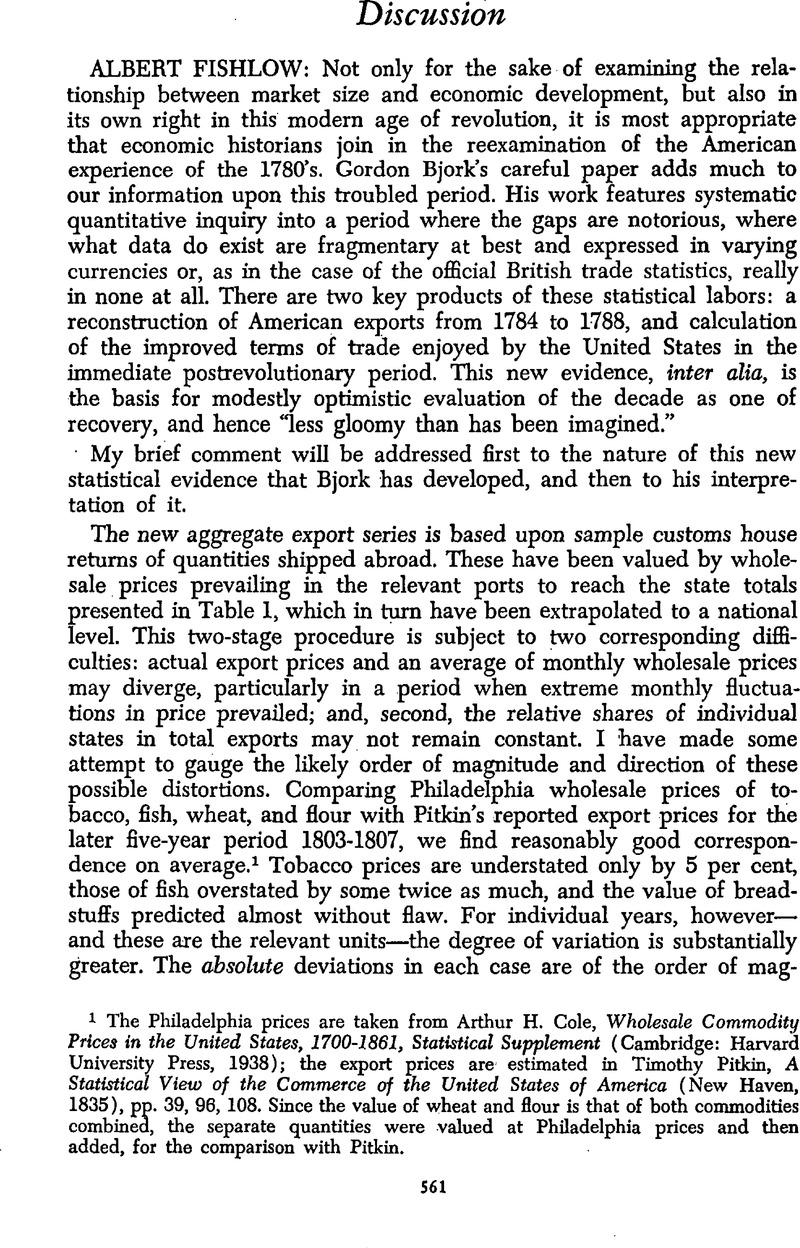Article contents
Discussion of Bjork paper
Published online by Cambridge University Press: 03 February 2011
Abstract

- Type
- Discussion
- Information
- Copyright
- Copyright © The Economic History Association 1964
References
1 The Philadelphia prices are taken from Cole, Arthur H., Wholesale Commodity Prices in the United States, 1700–1861, Statistical Supplement (Cambridge: Harvard University Press, 1938)Google Scholar; the export prices are estimated in Pitkin, Timothy, A Statistical View of the Commerce of the United States of America (New Haven, 1835), pp. 39, 96, 108Google Scholar. Since the value of wheat and flour is that of both commodities combined, the separate quantities were valued at Philadelphia prices and then added, for the comparison with Pitkin.
2 See Buron, Edmond, “Statistics on Franco-American Trade, 1778–1806,” Journal of Economic and Business History, IV (May 1932), 571–80Google Scholar.
3 Kohlmeier, A. L., “The Commerce between the United States and the Netherlands, 1783–1789,” Indiana University Studies, XII (1925), 3–47Google Scholar, esp. 28 ff. Kohlmeier's assertion that American exports to the Netherlands in 1788 were as much as $4.5 million (p. 25) can hardly be correct. In 1790, when official statistics begin, the Dutch were taking only $2 million, or 10 per cent, out of an expanded total.
4 Export quantities of breadstuffs and tobacco for 1770 were taken from Historical Statistics of the United States (Washington: U. S. Government Printing Office, 1960), pp. 761, 767Google Scholar. Current prices used to value them were taken from Bezanson, Anne, et al. , Prices and Inflation During the American Revolution (Philadelphia: University of Pennsylvania Press, 1951)Google Scholar; (the price of common flour was used to value flour and bread). Dollar values for the two classes of commodities in 1790 were taken from Coxe, Tench, A View of the United States of America (Philadelphia, 1794), pp. 281–84Google Scholar.
5 Bezanson, Prices and Inflation p. 268.
6 See Coxe, Views of the United States, p. 284, for the 1790 quantity and value of tobacco exports. (Hogsheads were taken as 1,000 pounds.)
7 See Table 2 and Historical Statistics, p. 757.
8 For Philadelphia prices, Bezanson (1951) has been used. Amsterdam prices may be found in Posthumus, N. W., Inquiry into the History of Prices in Holland (Leiden: E. J. Brill, 1946)Google Scholar. Amsterdam guilders were converted to British shillings, using the varying exchange rates presented on pp. 605–10. These were converted in turn to Pennsylvania shillings, using the table of exchange rates in Bezanson, p. 346, for the postwar period, and a par conversion earlier. Finally, a rate of 7.5 shillings to a dollar was used as in Cole, Supplement, p. ix.
9 Harper, Lawrence A., “The Effect of the Navigation Acts on the Thirteen Colonies,” reprinted in Schieber, Harry W., ed., United States Economic History (New York: Knopf, 1964), p. 66Google Scholar. Harper recognized the need for comparative European wholesale prices, but Posthumus researches were not available at that time.
10 Exports per capita are taken from North, Douglass C., “Early National Income Estimates of the United States,” Economic Development and Cultural Change, IX (Apr. 1961), 390Google Scholar; for a discussion of various income projections see North, also Parker, William N. and Whartenby, Franklee, “The Growth of Output Before 1840,” in Studies in Income and Wealth, Vol. XXIV, Trends in the American Economy in the Nineteenth Century (Princeton: Princeton University Press, 1960)Google Scholar.
- 2
- Cited by


